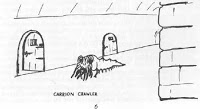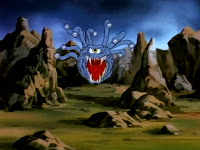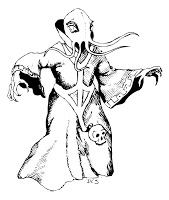One of the things that’s always puzzled me is why, when WotC was putting together the System Reference Document (SRD) for Dungeons and Dragons 3.X, they took several creatures out of public circulation by name, by declaring them as part of their Product Identity. For those who might not remember the whole list, here it is:
- beholder
- gauth
- carrion crawler
- tanar’ri
- baatezu
- displacer beast
- githyanki
- githzerai
- mind flayer
- illithid
- umber hulk
- yuan-ti
I’ve got to admit, I had to turn to Google to find out what a gauth was. But the other choices are no more clear to me now than when they first came on the scene. What is so special about these twelve (11, really; mind flayer and illithid being different names for the same creature) that makes them part of the Product Identity of D&D?
This certainly can’t be an attempt to cripple other companies from making a D&D emulator; both S&W and LL proved that with their only-slightly-different names for the carrion crawler. Tanar’ri and baatezu were always demons and devils anyway, so that’s a no-brainer. And if they thought enough of the mind flayers to declare their other name, illithid, as product identity, why didn’t they also include the other name of the beholder? Why is eye tyrant missing from the list?
 Beholders and mind flayers I can almost understand. They’re certainly an original creation for the game, and an iconic image to be sure. But umber hulks? Yuan-ti? Displacer beasts? These are hardly definitive creatures as far as I can tell. Certainly they don’t seem to be a part of what I might call the “product identity” of the game. And yet here they are. I confess to a certain level of bafflement.
Beholders and mind flayers I can almost understand. They’re certainly an original creation for the game, and an iconic image to be sure. But umber hulks? Yuan-ti? Displacer beasts? These are hardly definitive creatures as far as I can tell. Certainly they don’t seem to be a part of what I might call the “product identity” of the game. And yet here they are. I confess to a certain level of bafflement.
Anyone have any insights into why these 12 were chosen as the Forbidden Dozen?











I was thinking about this the other day during my commute after reading Zak S's litany of C monsterS on his D&D with Porn Stars blog. Why would anyone want to keep the carrion crawler exclusive?
And the drow aren't forbidden?
Just guessing, those are probably the D&D monsters that the WOTC lawyers felt were not already in the public domain.
I'm not sure if "drow" was an original name, but certainly dark elves existed in literature before they appeared in D&D.
If Wikipedia is to be believed, "drow" is a Scottish term cognate to the ON dökkálfar, and the term as such would not be exclusive.
Surely modrons, demodands, death knights, kuo-toa, sahuagin, ropers, slaad, etc. are also not in the public domain…
I just don't see the rhyme or reason behind the choices.
There's a lot more than twelve excluded monsters. It was basically any monster that was created whole-cloth by TSR, like aboleths and kuo-toas, was not included. Those are all considered to be copyrightable IP and therefore excluded from the SRD. On the other hand, stuff from old literature, myth, and legend, like centaurs, orcs, and dragons, can't be copyrighted, and so are free to do with as thou wilt.
The real oddity is that the displacer beast is one of the forbidden ones, given that it's a complete and utter rip-off of the couerl from A.E. van Vogt.
Still the best rule of thumb for OGL/d20 – design using the SRD only, not the Monster Manual (or other core books the SRD is derived from). If it's in the SRD, it's okay to use. So when designing your own product under the OGL, just pretend the Core Rulebooks and all other WotC books don't exist and use only the SRD.
Note, however, there can be some text in monster descriptions in the MM that isn't in the SRD, even though the monster's name and stats may be in the SRD. You can't use that text if it isn't in the SRD.
@Al: Actually, aboleths are in the SRD. But you are right, there are a lot of monsters not in the SRD from other, non-core WotC books like Kuo-Toa.
Two little 3PP treasures I'd like to mention – The Iconic Bestiary: Classics of Fantasy by Ari Marmell (Lion's Den Press) contains several of the "Banned 11" monsters with the serial numbers filed off.
The Tome of Horrors Revised Edition (Necromancer Games) has many Open versions (with the permission of WotC) of monsters from the 1e Fiend Folio, 1e MMII as well as older DRAGON Magazines. Definitely worth a look if you are assembling an OGL Section 15 for a retro-clone…
Forgot to mention (since this is an Old School site), those 3PP titles I mentioned are for d20/3.5e and from third party publishers (3PP). Still, they can be useful when "retrocloning" I suppose, at least as far as the OGL Section 15 is concerned.
I'm not generally one for later edition monsters, but the Gauth just looks awesome, like Gene simmons and a beholder got it onnnnn.
Should shrieker and rust monster be on this list along with carrion crawler?
If a monster is in the SRD, you can use it. If it isn't, you can't. Both the Rust Monster and the Shrieker (listed under Fungus) are in the SRD, so you can use them.
Here's a link to a very good and complete online SRD:
http://www.d20srd.org
Remember, WotC books contain no Open Game Content within (all their books including the core three (PHB, MM, DMG) are entirely closed – legally speaking, they aren't even published under the Open Game Licence and are protected under US Copyright Law only). The only Open Game Content Wizards has released is in the SRD which is published under the OGL.
There were two exceptions – WotC's Unearthed Arcana was declared Open (and it's contents are included in the link I gave above). Also, Monster Manual II was published under the OGL but only two monsters were released as Open Content, Scorpionfolk and Razor Boar, and both of those were originally from Necromancer Games's Creature Collection. Both those monsters are also included in the SRD I linked above. WotC did this as part of a reciprocal deal with Necromancer that allowed the publication of the Tome of Horrors which included many conversions of monsters from 1e books like the Fiend Folio and the original MM II. WotC gave them permission to use their IP and make the content Open, and at the time said they wouldn't publish versions of these monsters in any of their books. Later they went back on their word, and while WotC versions of these old classics are not Open, the Necromancer Games versions remain Open nonetheless because of the OGL.
WotC did declare some terms as Product Identity in the SRD:
Dungeons & Dragons, D&D, Dungeon Master, Monster Manual, d20 System, Wizards of the Coast, d20 (when used as a trademark), Forgotten Realms, Faerûn, character names (including those used in the names of spells or items), places, Red Wizard of Thay, Heroic Domains of Ysgard, Ever-Changing Chaos of Limbo, Windswept Depths of Pandemonium, Infinite Layers of the Abyss, Tarterian Depths of Carceri, Gray Waste of Hades, Bleak Eternity of Gehenna, Nine Hells of Baator, Infernal Battlefield of Acheron, Clockwork Nirvana of Mechanus, Peaceable Kingdoms of Arcadia, Seven Mounting Heavens of Celestia, Twin Paradises of Bytopia, Blessed Fields of Elysium, Wilderness of the Beastlands, Olympian Glades of Arborea, Concordant Domain of the Outlands, Sigil, Lady of Pain, Book of Exalted Deeds, Book of Vile Darkness, beholder, gauth, carrion crawler, tanar’ri, baatezu, displacer beast, githyanki, githzerai, mind flayer, illithid, umber hulk, yuan-ti.
There are still a ton of monsters in other WotC MMs and sourcebooks you can't use that are not Open Game Content and not in that Product Identity list because those books weren't published under the OGL and thus protected by US Copyright Law only – you don't need to declare them Product Identity if you aren't using the OGL.
The SRD and OGL are a great resource for retrocloners. Just be careful what you use (make sure you design your games for publication from the text of the SRD only and not WotC core rulebooks).
Hope that helps.
One last thing since Joe asked and then I'll shut up. So why do only certain names appear in that Product Identity list and not other ones like Slaad or Death Knights that also aren't Open Content?
As far as I can tell, those Product Identity names all appear in the three 3.5e core rulebooks, whereas Slaad et al. do not. WotC was just trying to cover itself legally and reinforce the concept that only what is in the SRD is Open.
Seeing that the name"githyanki" was "yoinked" from The Dying of the Light by George Martin, I don't see how it could be considered WOTC intellectual property.
Also, an interesting corollary to "drow" being a cognate of dökkálfar, is that the word may also be a cognate of draugr. The distinctions between various sorts of mound-dwelling supernatural beings seem to be lost in the intervening years.